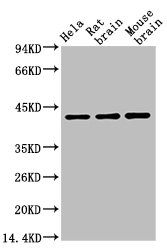Mouse anti actin beta-cytoplasmic
MUB0110P-CE/IVD
ApplicationsFlow Cytometry, Western Blot, ELISA, ImmunoHistoChemistry, ImmunoHistoChemistry Frozen, ImmunoHistoChemistry Paraffin
Product group Antibodies
ReactivityChicken, Human, Mouse, Porcine, Rabbit, Rat, Zebra Fish
TargetACTB
Overview
- SupplierNordic-MUbio
- Product NameMouse anti actin beta-cytoplasmic
- Delivery Days Customer7
- Application Supplier Note4C2 is useful for immunohistochemistry on frozen and paraffin-embedded tissues, immunoblotting, flow cytometry and ELISA. Optimal antibody dilution should be determined by titration; recommended range is 1:100 - 1:500 for immunohistochemistry with avidin-biotinylated horseradish peroxidase complex (ABC) as detection reagent, and 1:1000 - 1:5000 for immunoblotting applications.
- ApplicationsFlow Cytometry, Western Blot, ELISA, ImmunoHistoChemistry, ImmunoHistoChemistry Frozen, ImmunoHistoChemistry Paraffin
- Applications SupplierImmunohistochemistry (frozen);Immunohistochemistry (paraffin);Western Blotting;Flow Cytometry;ELISA
- CertificationResearch Use Only
- ClonalityMonoclonal
- Clone ID4C2
- Gene ID60
- Target nameACTB
- Target descriptionactin beta
- Target synonymsBKRNS, BNS, BRWS1, CSMH, DDS1, PS1TP5BP1, THC8, actin, cytoplasmic 1, I(2)-actin, PS1TP5-binding protein 1, beta cytoskeletal actin
- HostMouse
- IsotypeIgG1
- Protein IDP60709
- Protein NameActin, cytoplasmic 1
- Source4C2 is a mouse monoclonal IgG1 antibody derived by fusion of NS0 mouse myeloma cells with spleen cells from a BALB/c mouse immunized with a peptide comprising the N-terminal nonapeptide of beta-cytoplasmic actin with an acetylated N-terminus ...
- ReactivityChicken, Human, Mouse, Porcine, Rabbit, Rat, Zebra Fish
- Reactivity SupplierChicken;Human;Mouse;Rabbit;Rat;Swine;Zebrafish
- UNSPSC12352203







